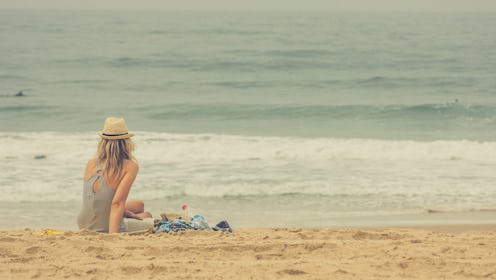Style
This Is How Much Clothes Really Protect You From Sunburn
It's no secret that protection from the sun's UV rays is necessary year-round. But those rays can be tricky. After all, they can penetrate clouds when it's gloomy out, so what else can they get through? Can you get a sunburn through your clothes? Even though it seems like your clothes should be able to protect you from sun damage and burns, you can never be too careful. So I emailed with dermatologist Dr. Amy Brodsky to see just how much protection your duds really offer.
According to Dr. Brodsky, UVB rays are what causes burns, and these rays can't go through most clothing. But even though you shouldn't get a sunburn under your clothes, it's still possible to experience some sun damage since UVA rays can penetrate your threads, she says. Of course, the type of clothing you wear can have an impact on how protected you are. Most common clothing, says Dr. Brodsky, offers an SPF 4-7. If you want to optimize that protection factor though, there are certain colors, styles, and types of fabrics that can help. Here are seven tips for getting the most sun protection from your clothes, so you know you're truly covered:
1. Synthetic Fabrics Are Better
When it comes to what types of fabric offer the best protection, Dr. Brodsky says, "The tighter the knit or weave, the smaller the holes and the less UV can get through." She adds that synthetic fabrics such as polyester, lycra, nylon, and acrylic tend to be more protective than bleached cottons.
2. So Are Matte Ones
Matte fabrics that absorb rather than reflect UV like linen are also better in the way of sun protection, says Dr. Brodsky. Shiny, semi-synthetic fabrics like rayon on the other hand, tend to reflect more UV rays, which won't reduce exposure.
3. Go Dark
Even though lighter colors including whites and pastels feel cooler in the summer, they may not offer as much protection. Dr. Brodsky explains that darker colors and bright colors like red tend to absorb more UV than lighter colors, which helps reduce UV exposure.
4. Stay Dry
If you need to optimize your sun protection, it can help to stay dry. According to Dr. Brodsky, if your clothes get wet, it actually lowers the SPF value.
5. Try A Wide-Brimmed Hat
Many of us probably turn to hats for extra sun protection, but the type matters. Dr. Brodsky says, "for every inch on your brim you decrease your risk of skin cancer by 10-percent." Therefore, baseball hats may not be the best choice, as they only offer protection on the forehead. If you want to keep your ears and back of your head sun-damage-free, opt for hat with a full and wider brim.
6. Layering Helps
Although layering can be uncomfortable if it's hot outside, it can help offer extra sun protection in a pinch, says Dr. Brodsky. Try light linens or silks if you want a layering option that won't pack on too much heat.
7. Try Sun-Protective Apparel
Of course, if you don't want to limit yourself to colors or fabrics for a day spent outside, try sun-protective apparel like this that offers Ultraviolet Protection Factor (UPF) 50, so you know wherever it's covering you, it's protecting you from sun damage.
After all, a little extra protection never hurt.
